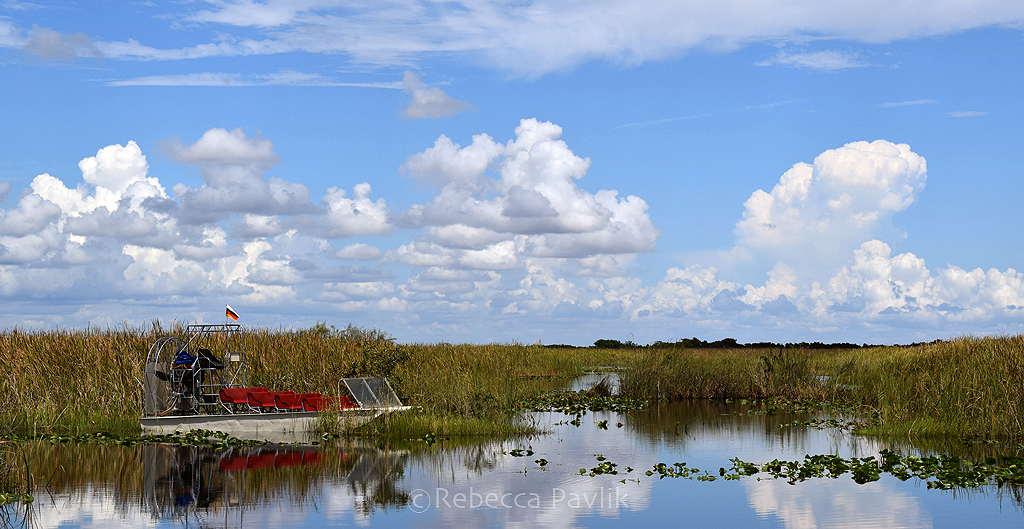There was no pulling off to the side of the road, and there were no ten-foot alligators just hanging out on the side of the road waiting to have their picture taken. Conquering the Everglades in the extreme heat of September proved to be much more challenging than I had anticipated. It took a second trip, a few years later, and staying several nights in Everglades City, to really explore the Everglades. For some important Florida Everglades travel tips, please keep reading.
Here’s what I Wish I had Known:
You might drive all the way across the Everglades on U.S. Highway 41 (the Tamiami Trail) and not see a single alligator. I didn’t realize this, but it all depends on the time of year and time of day, and how high the water is. On my first trip to the Everglades, we drove through along highway 41 the last week of September and after hurricane Hermine, the water was high. Well, we did see a few, but I can count them on one hand. A few of those we saw on our airboat tour and a few in the man-made drainage canals in Miami’s suburbs. You have to get off the main road to really see a lot of wildlife and alligators.
There’s no safe place to pull over on the side of highway 41 to take photos. Highway 41, The Tamiami Trail, is narrow and there is only one lane each way. You may also have someone right behind you hoping to pass you as soon as they can, which makes it hard to just pull over whenever you feel like it. The real problem though is that there is no safe place to stop on the side of the road. You will need to plan on stopping at the visitor’s centers, the airboat tour places, and the wooden boardwalk trail sites to safely get photos.

Florida Everglades – A very informative alligator show was included with our airboat tour at Gator Park
You also won’t see the hidden beauty of the Cypress swamps from the main road while driving through. Granted, you do see the expanse of the Everglades, which is lovely and interesting, but the landscape doesn’t change much. It’s possible that you won’t see any alligators or other wildlife from the road other than a few birds. For this reason, I highly recommend taking an airboat tour, stopping at some of the park’s scenic boardwalk trails and visitor centers, and taking one of the scenic drives, such as Loop Road.
For wildlife viewing and great photos, take the Loop Road scenic route. Loop Drive is a 27 mile dirt road with incredible photo opportunities in the Big Cypress National Preserve. You really have to slow down and get off the main road (the 41) to photograph the Everglades and Big Cypress National Preserve. We took this scenic route the second time we visited the Everglades and it was well worth the time. Give yourself around three hours, give or take, to enjoy this incredible drive. You will probably be pulling your car over every mile or so to take photos. Everything here looks like a scene out of a National Geographic special. You’ll see a lot of alligators, herons, wood storks and other wildlife just posing in a beautiful swamp setting.
For a guided overview, I recommend the Shark Valley Tram Tour. This highly informative tram tour, narrated by an Everglades park ranger, is two hours long, and takes visitors on a unique tour of the Everglades, including a large lookout tower. There are also walking trails and bike trails at Shark Valley, so plan to spend at least 3 or 4 hours in this location. You’ll see a lot of alligators and other wildlife all along the trails and on the tram tour.
You may not see much, if any wildlife on your airboat tour. It all depends on many factors — but airboats are very noisy and scare away most of the critters. Plus, it’s almost impossible to get great photos when going full speed in an airboat. We did see some baby alligators while we were going slow, so I guess they weren’t scared of the boat, and also one adult gator and an egret, but that’s it. Gliding through the sawgrass is thrilling though, and totally worth it to immerse yourself in this strange and beautiful landscape.
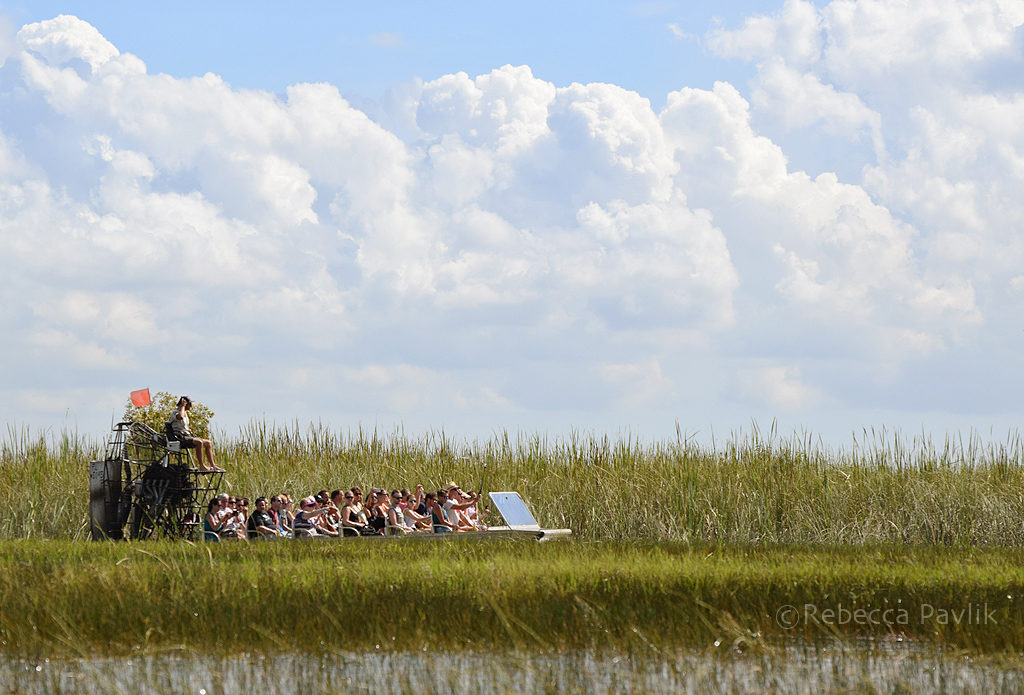
Our Florida Everglades group airboat tour with Gator Park, located right on highway 41
Opt for the longer airboat tour or a private tour if you can afford it. Our group airboat tour at Gator Park cost about $25 per person (at the time) and only lasted a half hour, but included a live alligator show after the boat ride which was extremely educational. Next time I will try to find a longer tour or private tour. The private tours at Gator Park were $300 (at the time), which isn’t that expensive if you’re splitting the cost among four or five people, but we weren’t so we skipped it. Prices have gone up of course, so check their website ahead of time.
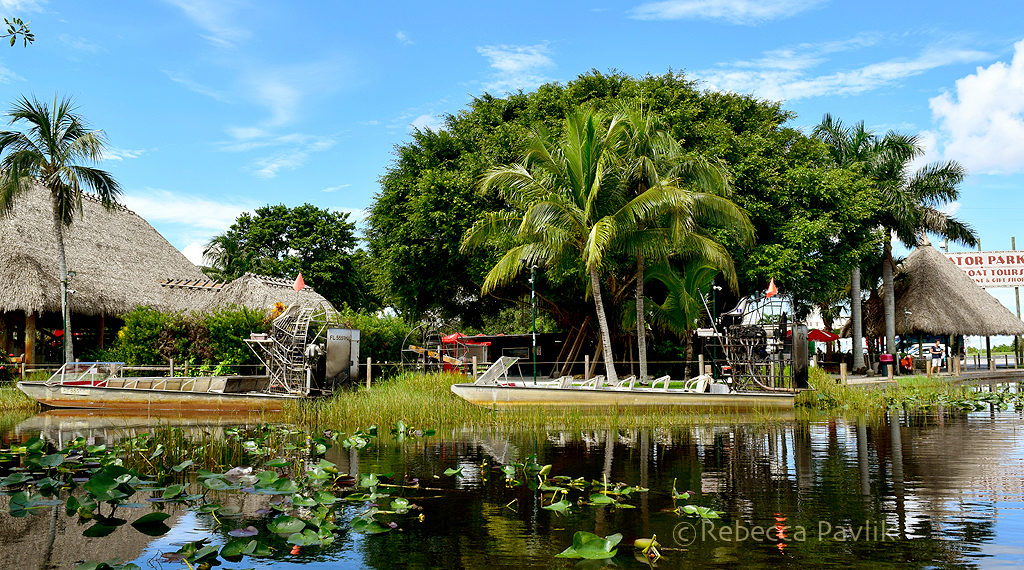
Gator Park, where we did our airboat tour and alligator show. They also have a cafe that serves alligator (it tastes like chicken).
For the best photos, try to do some sightseeing at sunrise or late afternoon to sunset. My airboat tour photos would have been so much more dramatic if the sun was setting. Call ahead and find out if you can take an airboat tour at sunrise or sunset. I know it’s hard to plan exactly where you’ll be at “magic hour” but if you’re a serious photographer it’s worth the effort. Photographing the Everglades is just as much about the sky and the light since it’s so flat (kind of like photographing a wheat field).
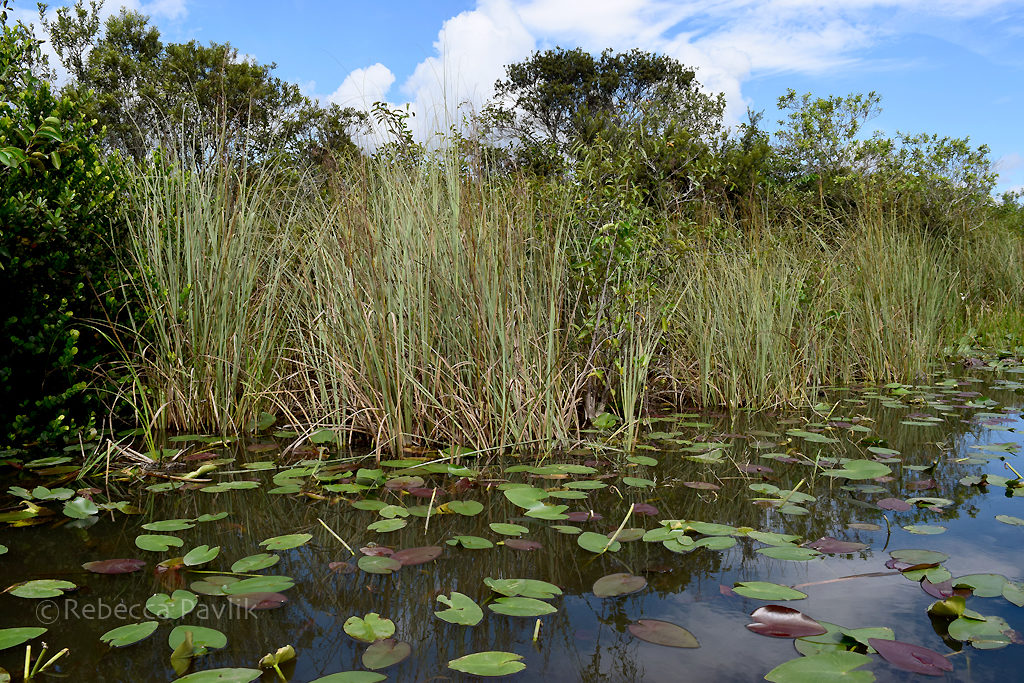
Everglades – Photo taken on our airboat tour
There is no quick or fast way to really see the Everglades. It’s best to give yourself several days, if possible. The speed limit on Highway 41 is only 55 miles per hour tops, and in some places it drops down to 50 and even 45 mph, where there are Florida panther crossing signs. There is no zipping through the Everglades at 70 mph, unless you take the more northern route, which is an actual freeway/interstate. Even if you could, you wouldn’t see much. I liked going slow and taking in the scenery, it’s just that it took a lot longer than road trips I’ve taken out west. You’ll be going extremely slow if you take the Loop Road scenic drive, which I can’t recommend enough. You’ll probably be going around 20 miles an hour on that road, and it’s 27 miles long. The Shark Valley tram tour takes a long time as well. You’ll probably want to spend at least three hours there, including the tram tour and walking trails.
It was even hotter than I expected — and I live in Florida! We went in mid September and it was miserably hot. Just walking around to take a few photos was painful. I don’t recommend visiting in the summer — aside from the fact that we saw almost no alligators on our first trip, it was just too darn hot to really enjoy the outdoors. Also, don’t forget your bug spray! Unless you visit on a cold windy day, you will definitely need mosquito repellant in the Everglades.
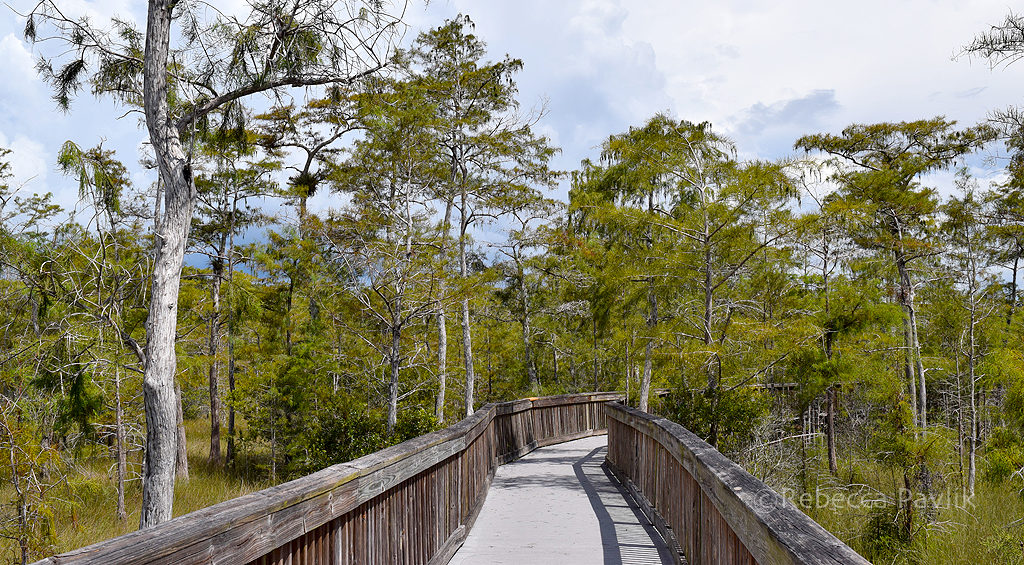
Kirby Storter trail, along highway 41 in Big Cypress Nat. Preserve
You will drive right past the best sight-seeing and photo opportunities, if you don’t know about them ahead of time. The park’s signs are very small and don’t exactly advertise what you’ll see. Do your research ahead of time and pick three or four places you plan on stopping. Then keep an eye out for the signs — they’re small and easy to miss. You simply can’t tell from the road what’s going to be interesting. You really have to get off the road and take a hike, an airboat ride or tram tour to really get a feel for the Everglades. Again, I highly recommend stopping at Shark Valley visitors center and taking the tram tour.
Another “most see” stop for art lovers and photographers is Clyde Butcher’s Big Cypress Gallery, also on highway 41. Clyde Butcher is considered the Ansel Adams of Florida landscape photography. His gorgeous black and white fine art photographs capture the beauty of the Everglades and other Florida landscapes in a way that few can rival. Clyde Butcher is famous here in Florida and anyone stopping at his gallery will not be disappointed. The gallery also offers Swamp Walk Eco Tours and guided Photo Safaris.
My favorite walking trail was the Kirby Storter boardwalk in Big Cypress National Preserve. This short trail is easy to miss because the sign is so small and you can’t see the swamp from the road. It’s the one sight-seeing trail that should not be missed, especially if you don’t have time to take the Loop Road scenic drive. This walking trail has a raised wooden boardwalk that goes right through the middle of a gorgeous cypress swamp.
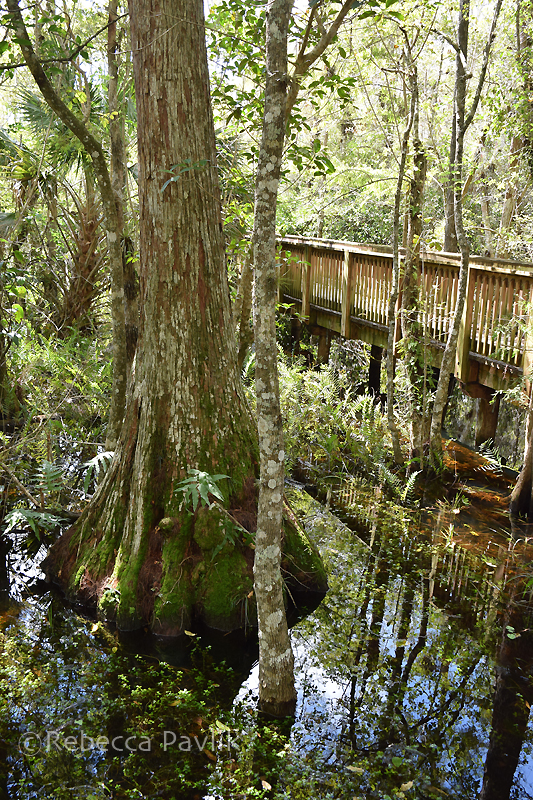
Kirby Storter trail in Big Cypress Nat. Preserve
The photo opportunities are endless here, although I didn’t see any alligators. You would not know from driving by just how different the landscape looks once you’re on the trail. Even the beginning of the trail is misleading. In fact, my mother and boyfriend, overwhelmed by the extreme heat and underwhelmed by the modest scenery at the start of the trail, turned around before they made it to the best part of the trail. The trail curves, suddenly you are surrounded by giant cypress trees, in a beautiful and magical swamp — I felt like I was in the middle of a National Geographic documentary. The Kirby Shorter trail is the one stop you should make (other than the Shark Valley Tram Tour and Visitor’s Center) on your drive through the Everglades on highway 41.
After my first, and rather impromptu, visit to the Everglades (we drove through on our way to Key West), I realized that an Everglades visit must really be planned or you will miss the best stuff. The best scenery doesn’t jump out at you like the Rocky Mountains or Monument Valley.
It wasn’t until I took another 3-day Everglades trip that I really got experience the Everglades and Big Cypress National Preserve. You have have to slow down and make more of an effort with the Everglades. Its quiet beauty, secret swamps, and elusive wildlife don’t necessarily reveal itself on the side of the road. You can easily drive straight through, get to the other side, and realize you missed it all.
For more information, sightseeing tours and things to do in the Everglades, click on the following links: www.stateparks.com/everglades and www.nps.gov/ever
For photos and more information about Big Cypress National Preserve, click here: www.nps.gov/bicy
For a list of Park Ranger led activities in Big Cypress (November through April) like canoe trips, swamp hikes, campfire talks, birding, astronomy programs, a triathlon and more, click here www.nps.gov/bicy/planyourvisit
© 2022 Rebecca Pavlik | TravlGusto
Stay in touch! Subscribe to TravlGusto’s monthly travel newsletter

